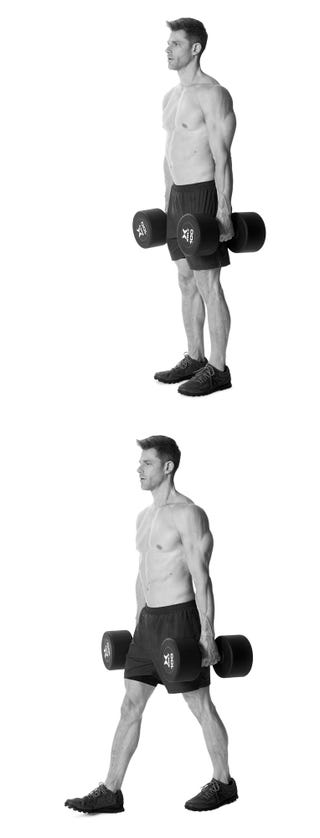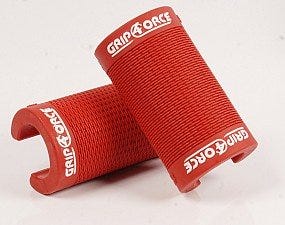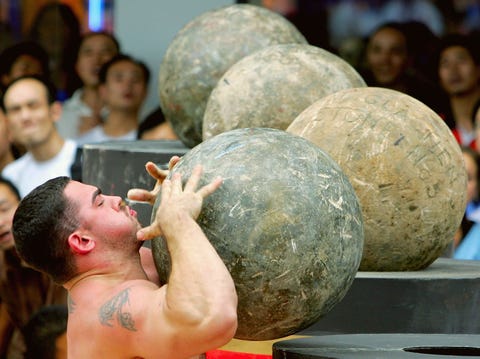
These days, people seem to be concerned with whether or not the workout they’re doing is “functional.”
While we think that basic free-weight exercises do enough to prepare you for whatever challenges you may face, there’s no question that strongman training can take your performance outside the gym to the next level. After all, if you can flip a 500-pound tire, you can probably pick up your children or push a sofa across your living room floor with no problem.
The unconventional lifting you see in the World’s Strongest Man contests challenges the body very differently from more orthodox exercises, offering great benefit to core and grip strength, and often doubling as cardio as well. Strongman training will also make you more of a man: The Journal of Strength and Conditioning Research found that men who did strongman workouts saw a 74 percent spike in testosterone levels right afterward.
But, unless you can find a dedicated strongman gym to train in, you’ll have to procure some of the implements you’ll need to do strongman lifts on your own, or approximate them with tools you already have. Either way, adding strongman exercises to your workouts makes training fun and, yes, undeniably functional. We promise.

Men’s Health
Order Now
For a full compendium of fitness knowledge, check out the Men’s Health Encyclopedia of Muscle. The volume is chock full of workout routines, helpful training tips, and definitions for just about every gym-related term you’ve ever wanted to know.
How to Use Strongman Exercises
According to C.J. Murphy, a coach and owner of Total Performance Sports in Boston, there are four common strongman competition events that have the most carryover to what regular people (i.e., you and us) want to accomplish with their training (you can find these exercises in the Men’s Health Encyclopedia of Muscle).
“The farmer’s walk should be in everybody’s program,” says Murphy, and Atlas stone shouldering, tire flips, and thick-bar lifts would be great additions, as well.
You can work them into your routines here and there, as you see fit, or do them all together on what Murphy calls an event day. For example, you could do two or three conventional workouts in a week, and then spend Saturday drilling strongman lifts for a fun change of pace that tests your progress.
Farmer’s Walk

Mitch Mandel
Pretty simple: Pick up a pair of heavy dumbbells and walk briskly for as far as you can. Keep good posture—chest proud, standing tall and straight.
True strongmen use farmer’s walk handles, which are like carrying a barbell in each hand, and are, therefore, much harder to control, but dumbbells are a good substitute.
“You can go for short runs with very heavy weights, or long runs with lighter weights,” says Murphy. For example, to really fire up the muscles in your upper back, core, and forearms, grab the heaviest weights you can handle, and walk for 50 to 100 feet. If you want to challenge your endurance and rev up your metabolism, try going 100 to 300 feet with a lighter set of weights (lighter, not light).
Thick-Bar Lifts
Strongmen often lift tractor axles in competition. They may look like barbells, but their diameter is 2 inches, making them extremely challenging to grip. You can buy an axle or an assortment of other “fat” bars, or make a normal barbell thicker by wrapping a towel around it or, as Murphy prefers, using Grip4orce grips—rubber sleeves that slip onto a bar to instantly thicken it.

Unlike similar grip devices, the Grip4orce is designed to not fit the bar snugly, so you have to actively squeeze them while you lift for maximum muscle recruitment. “You can use a thick bar for deadlifting, rowing, and pressing,” says Murphy.
Be prepared to cut back on the weight you use considerably, but when you switch back to a conventional barbell in a few weeks, it will feel like a pencil in your hands, by comparison. A thick bar can be particularly good for relieving stress on your joints during bench presses. Because your hands are forced wider apart, the load is distributed more evenly down your wrists, elbows, and shoulders.
Atlas Stone to Shoulder

Getty ImagesChina Photos
You’ll need a stone, as nothing in a commercial gym can approximate it (you can make your own with a mold). Stone-lifting is similar to deadlifting, but controlling the stone’s smooth contours is much harder, and you’ll feel your upper back, chest, core, and forearms work like never before.
Straddle the stone so that the balls of your feet align with the stone’s centerpoint, and squat down to wrap your arms around it. Get your hands as close together and under the stone as possible without letting them get crushed—your fingernails should touch the ground Squeeze the stone in your arms and flatten out your lower back by drawing your shoulders back and down and trying to point your chest forward.
Drive through your feet to raise the stone off the floor. When it passes your knees, pull it into your lap and re-bend your knees, as if sitting down—the stone will act as a counterweight so you don’t fall backward. Reposition your arms about one-third down from the top of the stone in a bearhug. Squeeze the stone into your chest and dip forward slightly, then explosively extend your back, hips, and knees to stand up and heave the stone up to one shoulder. Stabilize it, and return the stone to the floor with control. (You’ll have to lay some mats down to protect the floor—and the stone— when it drops.) Alternate the side you lift the stone to with each rep.
Murphy recommends a 100-pound stone to start, which works well for conditioning workouts. “You can use it as part of a circuit.” For example, “shoulder the stone 15 times, then do 10 burpees, and then a farmer’s walk for 100 feet,” he suggests.
Tire Flip

Getty Imagesfranckreporter
Tire-flipping has been compared to power cleans for its potential to build explosive strength, and it will improve your cardio for short-burst activities (football plays, sprints). Murphy says that you’ll need at least a 350-pound tire (“that’s not heavy,” he says, “my son can do it”), which you can probably get for free at a junkyard or body shop. It should come up to at least the height of your knees when it’s lying on its side.
Lay the tire flat, and crouch behind it—you should be in a four-point stance (like an offensive lineman), up on the balls of your feet. Grip the tire with your arms outside shoulder width. Keeping your lower back flat and your butt down, push forward, driving your chest into the tire. Try to get it moving up at a 45-degree angle. Aim to extend your hips, knees, and ankles at the same time. As the tire moves upward, jump closer in to it, as you switch your hands to the tire’s side and press it forward and over. You may want to raise one knee up once you’ve lifted it to waist level, which will help to carry the tire’s momentum forward. Aim for three to four sets of five flips.
Source: Read Full Article
